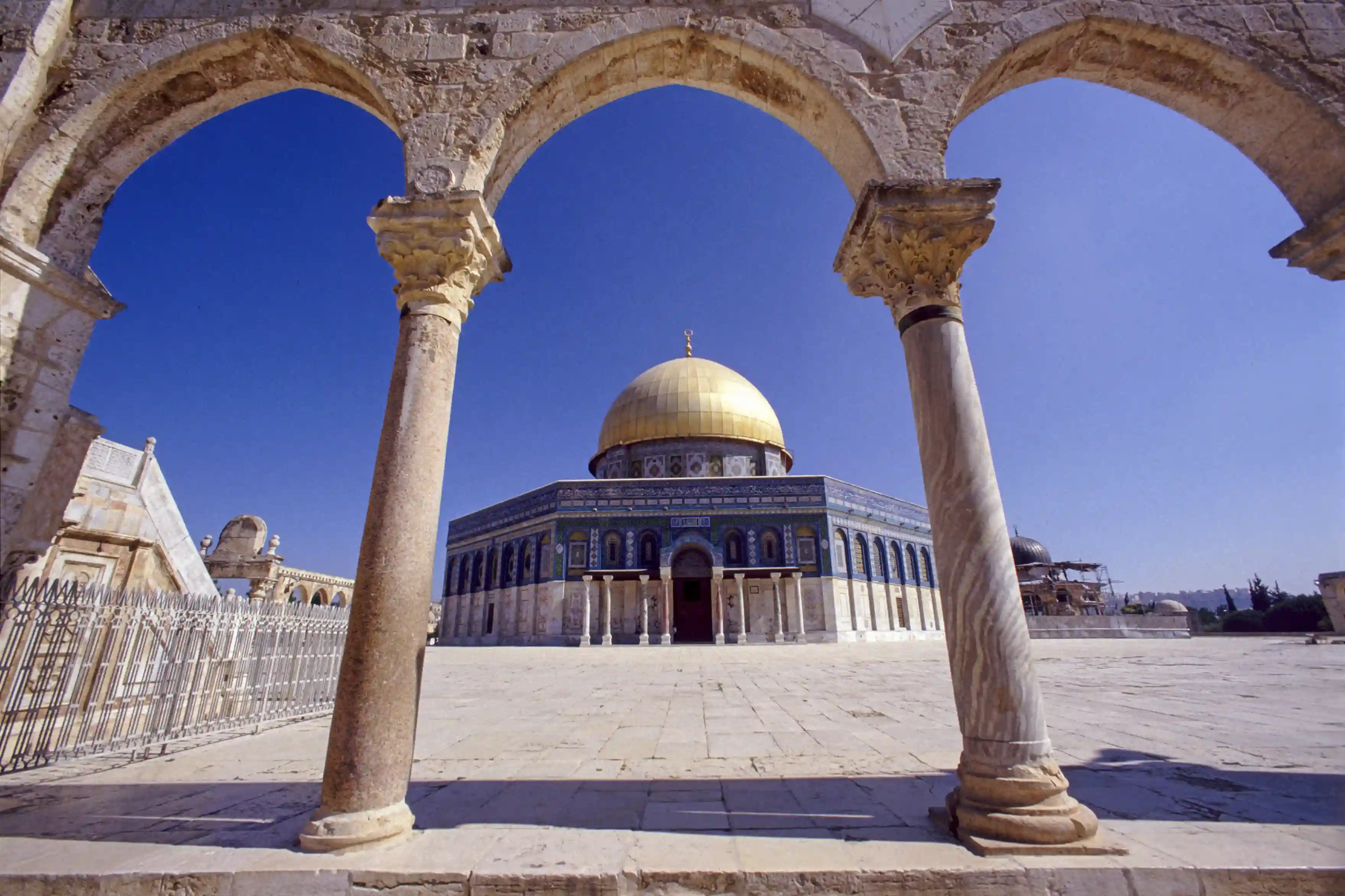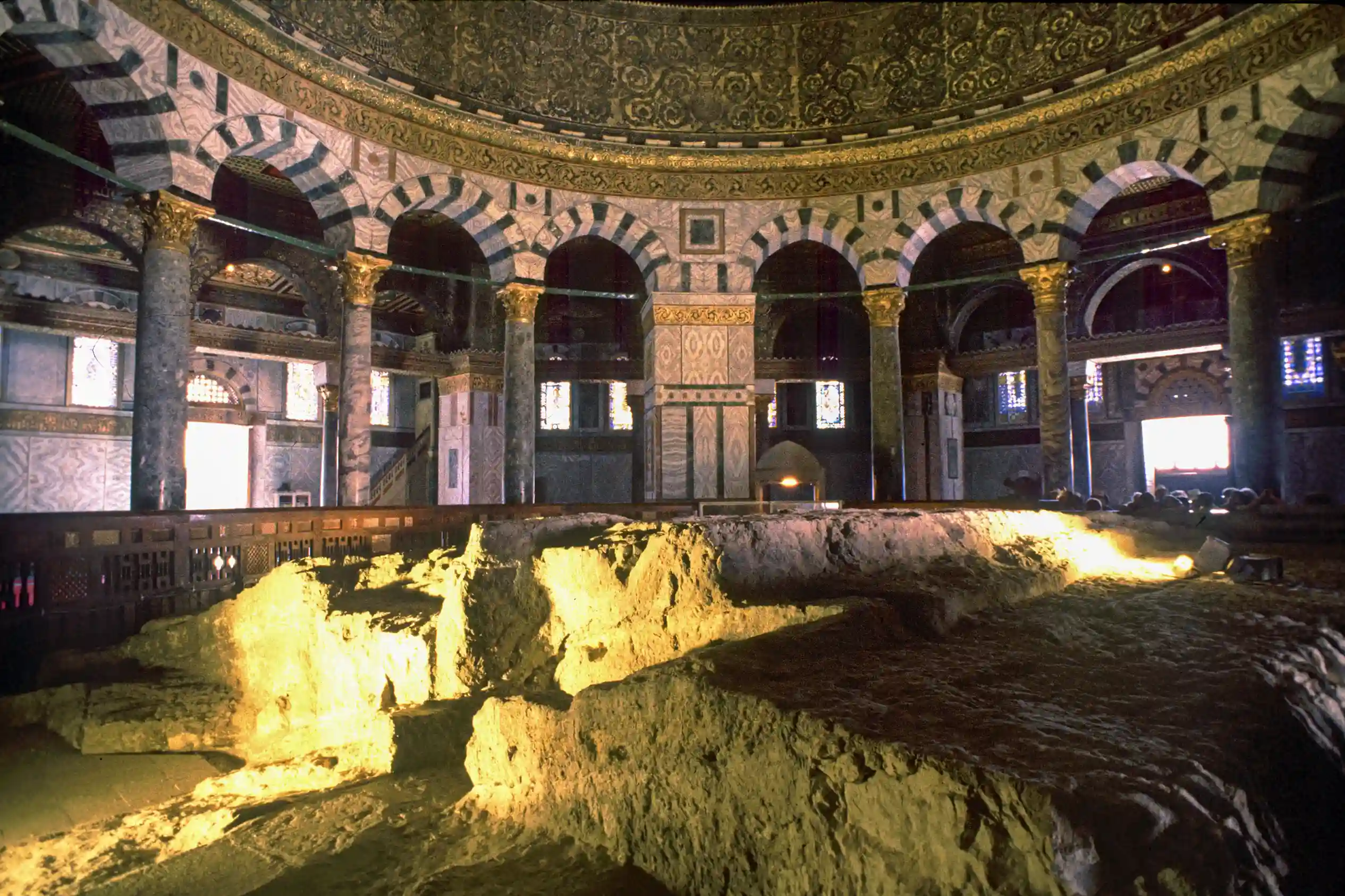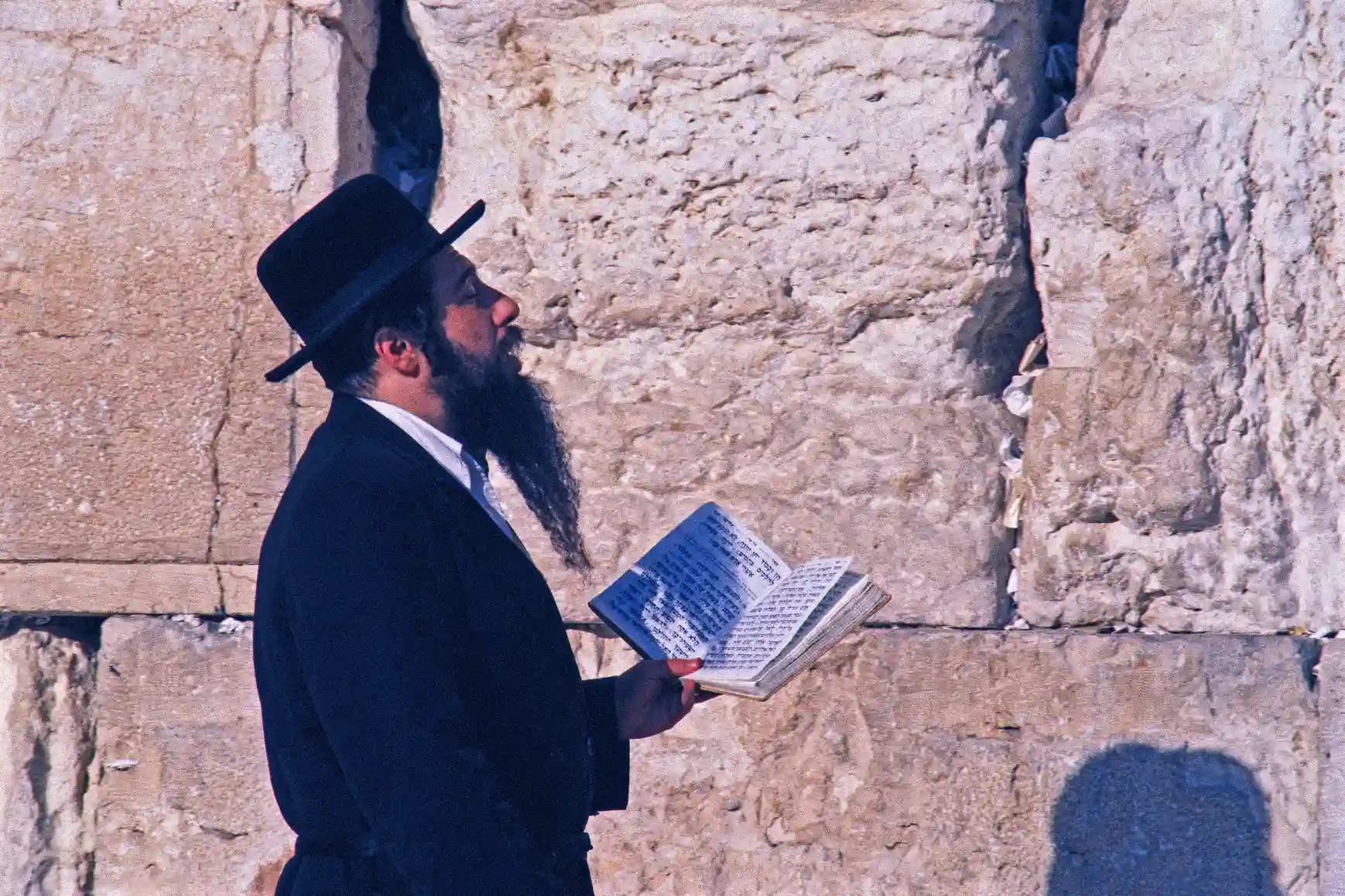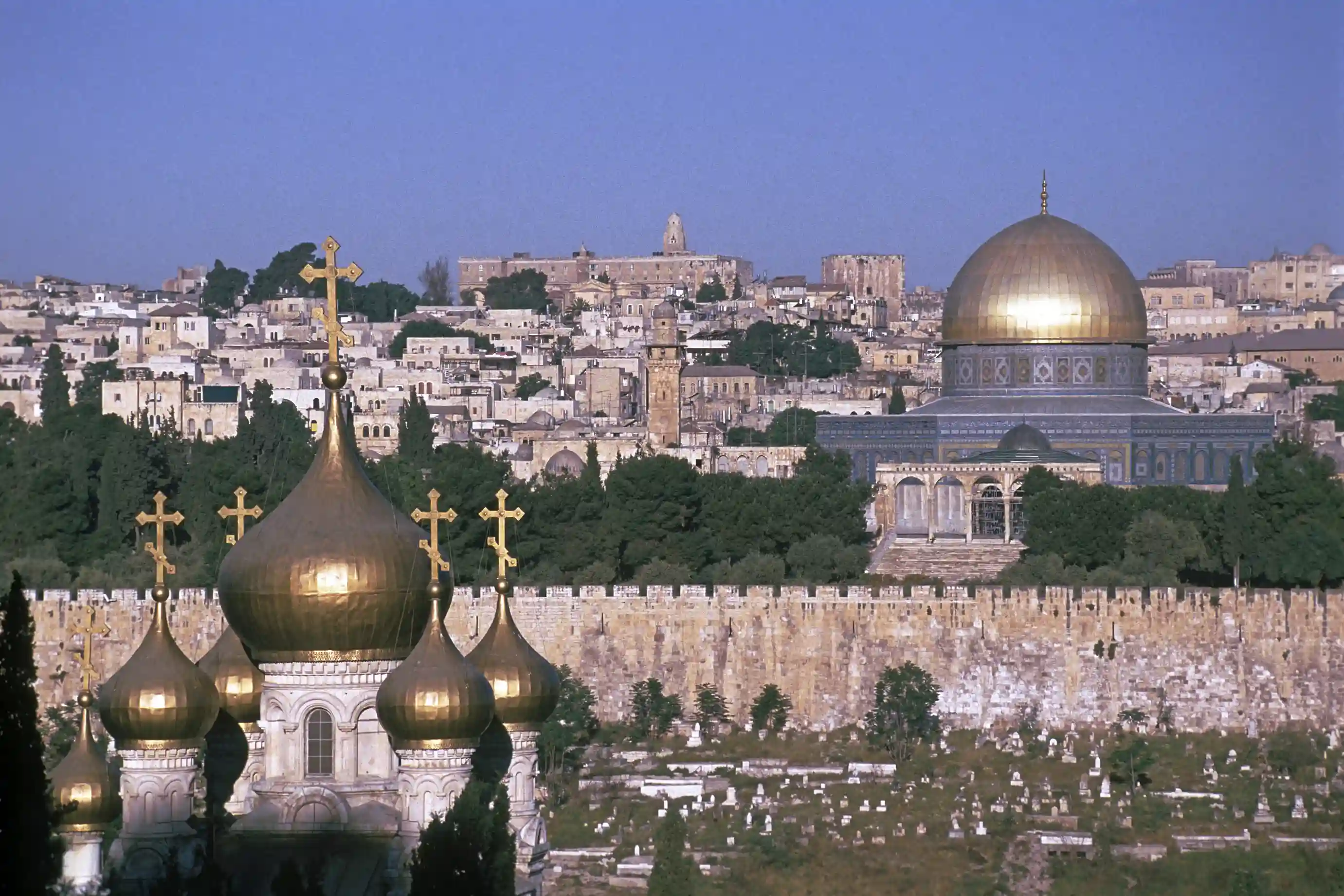Holy Sites of Jerusalem
By virtue of the number and diversity of people who have held it sacred, Jerusalem may be considered the most holy city in the world. To the Jewish people, it is Ir Ha-Kodesh (the Holy City), the Biblical Zion, the City of David, the site of Solomon's Temple, and the eternal capital of the Israelite nation. To Christians, it is where the young Jesus impressed the sages at the Jewish Temple, where he spent the last days of his ministry, and where the Last Supper, the Crucifixion, and the Resurrection took place. Also greatly venerated by the Muslims, it is where the prophet Muhammad ascended to heaven.
While highly charged with intense religious devotion and visited by countless pilgrims and sages, Jerusalem has also been ravaged by thirty centuries of warfare and strife. It is a place of beauty, divinity, mystery, and paradox, a sacred site that no modern spiritual seeker should fail to experience.
The earliest traces of human settlement in Jerusalem are from the late Chalcolithic and Early Bronze Age (3000 BC). Excavations have shown that a town existed on the south side of Mount Moriah, also called Temple Mount. The name of this town was Urusalim, a word probably of Semitic origin that means 'Foundation of Shalem' or 'Foundation of God.' On the frontier of Benjamin and Judah, the town was inhabited by a mixed population known as Jebusites.
About 1000 BC, Urusalim was captured by David, founder of the joint kingdom of Israel and Judah, and became the Jewish kingdom's capital. In the earlier wandering years of the Israelites, their most sacred object, the Ark of the Covenant, was periodically moved about among several sanctuaries, but following David's capture of Urusalim, the Ark was moved to that city around 955 BC. The Ark was a portable shrine containing the two stone Tablets of the Law that the prophet Moses had received upon Mount Sinai. David renamed his city Jerusalem, meaning 'City of Peace' in Hebrew, and chose Mount Moriah as the site of his future temple.
Mount Moriah was already considered highly sacred for several reasons. An ancient Semitic tradition stated that the bare rock atop the mount was held in the mouth of the serpent Tahum and that the place was the intersection of the underworld and the upper world. It was also considered the site where Abraham had built an altar on which he prepared to sacrifice his son Isaac. At this same site, the patriarch Jacob gathered a stone from the altar upon which his father Isaac was to be sacrificed and spent the night sleeping on the rock using this stone as a pillow. Upon waking from a stunning visionary dream, Jacob anointed the stone pillow with oil he had received from heaven and the stone then sank deep into the earth to become the foundation stone of the great temple that Solomon would later build. This hallowed site is known as Bethel, meaning "Gate or House of Heaven."
The First Temple
The First Temple of the Jews was built during the reign of David's son, Solomon. King David had planned to build the Temple at the exact place where he had experienced a revelatory vision of angels ascending a golden ladder into the sky. This site, the threshing floor of Ornan the Jebusite, was originally sacred to the harvest deity known as Tammuz (another name for the deity Adonis). God, through Nathan the prophet, rejected David's wish, evidently because he had shed blood, and instead informed him that the Temple would be erected by his son Solomon (II Sam.7:12-13).
The Temple's construction took seven years and was completed in 957 BC. Soon after the Temple's construction, Nebuchadrezzar II of Babylon forced the Jews into exile, removed their temple treasures in 604 BC and 597 BC, and finally destroyed the Temple in 586 BC. In 539 BC, Cyrus of Persia conquered Babylon and allowed the Jews to return to Jerusalem. Reconstruction began, and in 515 BC, the Second Temple was completed. This Temple, however, did not enshrine the Ark of the Covenant as that sacred object had disappeared sometime before the plundering by Nebuchadrezzar.
The British researcher Graham Hancock has investigated the date of the Ark's disappearance and its subsequent whereabouts - long a mystery to archaeologists, historians, and biblical scholars. In his richly detailed book, The Sign and the Seal, Hancock presents evidence that Jewish priests removed the Ark from Solomon's temple during the rule of the apostate King Manasseh (687-642 BC). The Ark was then hidden for two hundred years in a Jewish temple on the Egyptian sacred island of Elephantine in the Nile. Next, it was taken to Ethiopia, to the island of Tana Kirkos in Lake Tana, where it remained for over 800 years until being brought to the city of Axum, the capital of the Axumite kingdom. When that kingdom was converted to Christianity after 331 AD, the Ark of the Covenant was placed in a church of St. Mary of Zion, where it remains to this day.
Writing in his book Lost Secrets of the Sacred Ark, author Laurence Gardner disagrees with Hancock's assertions, stating that "the Axumite Ark, called a 'manbara tabot' is actually a casket which contains a venerated altar slab known as a tabot. The reality is that although the Axum chest might be of some particular cultural significance in the region, there are manbara tabotat (plural of tabot) in churches across the breadth of Ethiopia. The tabotat which they contain are rectangular altar slabs, made of wood or stone. Clearly, the prized manbara tabot of Axum is of considerable sacred interest and, by linguistic definition, it is indeed an ark - but it is not the biblical Ark of the Covenant, nor anything remotely like it."
Other sources researched by Laurence Gardner indicate that the Ark of the Covenant had been hidden beneath Solomon's Temple at the time of King Josiah (597 BC) so Nebuchadnezzar and the Babylonians could not seize it. In his Mishneh Torah of 1180, the Spanish philosopher Moses Maimonides wrote that Solomon had constructed a special hiding place for the Ark in tunnels deep beneath the Temple. The prophet Jeremiah, son of Hilkiah, who became the High Priest of Jerusalem, was the captain of Hilkiah's Temple Guard. Before Nebuchadnezzar's invasion, Hilkiah instructed Jeremiah to have his men secrete the Ark of the Covenant and other sacred treasures in the vaults beneath the Temple.
More than 1700 years later, a group of nine Frenchmen known as the original Knights Templars spent 1118 to 1127 excavating beneath the El-Aqsa mosque on the site of the old Temple of Jerusalem. In addition to a vast wealth of gold bullion and hidden treasures, they retrieved the true Ark of the Covenant. While the existence and exact location of this Ark are not currently known, the Templars soon became one of the most influential religious and political institutions in medieval Europe.
The Second Temple
Over the next five centuries, Jerusalem was captured by Alexander the Great, controlled by Hellenistic, Egyptian, and Seleucid empires, and experienced occasional periods of Jewish freedom. In 64 BC, the Roman general Pompey captured Jerusalem, ushering in several centuries of Roman rule. During this period, Herod the Great (ruled 37-4 BC) rebuilt and enlarged the Second Temple and created the famous Western Wall (also called the Wailing Wall) as part of the supporting structure for the enlarged Temple Mount. In 6AD, the Romans turned the governance of Jerusalem over to a series of administrators known as procurators, the fifth of whom, Pontius Pilate, ordered the execution of Jesus.
During the next two centuries, the Jews twice revolted against their Roman oppressors, the city of Jerusalem suffered greatly, and the Second Temple was demolished in 70 AD. In 135 AD, the Roman Emperor Hadrian began constructing a new city called Aelia Capitolina upon the ruins of old Jerusalem. On the site of the destroyed Jewish temple, Hadrian built a temple to the god Jove (the Greek Jupiter), but this temple was itself demolished by the Byzantines after the empire became Christian.
Church of the Holy Sepluchre
The conversion to Christianity of the Byzantine Emperor Constantine (306-337) and the pilgrimage of his mother, Empress Helena, to Jerusalem in 326 inaugurated one of the city's most peaceful and prosperous epochs. According to Christian legends, Empress Helena discovered the relics of the 'True Cross of the Crucifixion' at the place of the Resurrection upon Mount Calvary. Scholars, however, believe this so-called 'finding' of the relics to be a story fabricated for political reasons by Constantine and his mother and that the cross relics were most probably manufactured, as were so many other relics during early and medieval Christian times. Whatever the case, Helena's pilgrimage and Constantine's royal support made building many Christian shrines in the city possible.
Foremost among these Christian shrines was the Church of the Holy Sepulchre. This church marked the site of the Resurrection, and it soon became the supremely sacred place in all of Christendom. Completed in 335 AD, the church was built upon the foundations of an earlier Roman shrine dedicated to the goddess Aphrodite. During this splendid era of church construction, the tradition of Christian pilgrimages to Jerusalem began. The most visited pilgrimage sites were Bethlehem, where Jesus was born; Golgatha, the site of his death (and where legend says the skull of Adam was buried); the Church of the Holy Sepulchre; and the Mount of Olives, where Jesus (supposedly) ascended to heaven. The Christian glorification of Jerusalem was carried on until 614 AD, when the Persians invaded the city, massacred the inhabitants, and destroyed many of the churches and monasteries.
Dome of the Rock and Islamic Pilgrimage
Following a brief period of Persian rule, Jerusalem was captured in 638, six years after the death of Muhammad, by the Muslim Caliph Umar. Soon after his occupation of the city, Umar cleared the Temple Mount, built a small mosque, and dedicated the site to Muslim worship. The most imposing structure the Muslims found in Jerusalem was the Church of the Holy Sepulchre. Nearby, the Arab conquerors undertook to build a more spectacular edifice, the Dome of the Rock, to proclaim the supremacy of Islam and also to ensure that Christianity would not tempt the new followers of Islam. The site chosen was the very same rock where previously had stood the Jupiter temple of the Romans and, before that, the two temples of the Jews.
There was, however, another reason for the Muslim veneration of this particular site, one more important than the political expediency of usurping another religion's holy place. A particular passage in the Koran links the Prophet Muhammad with Jerusalem and the Temple Mount.
That passage, the seventeenth Sura, entitled 'The Night Journey', relates that Muhammad was carried by night 'from the sacred temple to the temple that is most remote, whose precinct we have blessed, that we might show him our signs.'
Muslim belief identifies the two temples mentioned in this verse as Mecca and Jerusalem. According to tradition, Muhammad's mystic night journey was in the company of the Archangel Gabriel. They rode on a winged steed called El Burak (meaning `lightning'), which, according to Islamic Hadith tradition, was a winged, horse-like creature "smaller than a mule, but larger than a donkey." Stopping briefly at Mount Sinai and Bethlehem, they finally alighted at Temple Mount in Jerusalem, where they encountered Abraham, Moses, Jesus, and other prophets whom Muhammad led in prayers. Gabriel then escorted Muhammad to the pinnacle of the rock, which the Arabs call as-Sakhra, where a ladder of golden light materialized. On this glittering shaft, Muhammad ascended through the seven heavens into the presence of Allah, from whom he received instructions for himself and his followers. Following his divine meeting, Gabriel and the winged horse flew Muhammad back to Mecca, arriving there before dawn.
At this hallowed site, known in Arabic as Haram al-Sharif, the 9th Caliph, Abd al-Malik, built the great Dome of the Rock between 687 and 691. Besides its association with Muhammad's `Night Journey,' Jerusalem was also chosen as the site of this first great work of Islamic architecture for political reasons. For a brief period between 680 and 692, Mecca became the capital of a rival caliphate established by Abd Allah ibn Zubayr, who controlled most of Arabia and Iraq. Following the retreat of the Umayyad army from its siege of Mecca, the construction of the Dome was undertaken to discourage pilgrimages to Mecca.
Often incorrectly called the Mosque of Umar, the Dome of the Rock, known in Arabic as Qubbat As-Sakhrah, is not a mosque for public worship but instead a mashhad, a shrine for pilgrims. Adjacent to the Dome is the Al-Aqsa Mosque, wherein Muslims make their prayers. Designed by Byzantine architects engaged by the Caliph, the Dome of the Rock was the most significant monumental building in early Islamic history and remains today one of the most sublime examples of artistic genius that humanity has ever produced (the Great Mosque of Damascus, being an actual mosque, is the earliest surviving monumental mosque).
The dome is 20 meters high and 10 meters in diameter, and its supporting structure, made of lead, was originally covered in pure gold. The real gold was removed over the centuries, and the dome is now made of anodized aluminum. The sacred foundation stone is encircled by sixteen arches that formerly came from different churches in Jerusalem that were destroyed during the Persian occupation of the city in 614 AD. Writing of the sublimely beautiful structure with its heavenly dome, its columns of rare marble, and its brilliant mosaics, the British authority on Muslim architecture, K.A.C. Creswell, exclaimed:
"Under a scheme whereby the size of every part is related to every other part in some definite proportion, the building instead of being a collection of odd notes becomes a harmonious chord in stones, a sort of living crystal; and after all it really is not strange that harmonies of this sort should appeal to us through our sight, just as chords in music appeal to our hearing. Some of the ratios involved are fundamental in time and space, they go right down to the very basis of our nature, and of the physical universe in which we live and move."
The Dome of the Rock, while certainly one of the world's great architectural masterpieces, is often incorrectly understood to be an Islamic creation. Writing about the non-Islamic influences on the architectural style of the Dome, the author of Muslim Religious Architecture, Dogan Kuban, comments that,
"Art historians have kept up an unceasing flow of studies of the Dome of the Rock. In the context of Islamic architecture it remains unique, but in that of Roman architecture its form is directly in line with the late tradition in Syria. All of its important features, from the interior double colonnades to the great wooden dome, have been shown to be faithful reproductions of features of the Cathedral of Bosra in southern Syria. Its well-known mosaic decoration is Islamic only in the sense that the vocabulary is syncretic and does not include representation of men or animals. The entire building might be viewed as the last blossoming of the Hellenistic tradition before the Islamic synthesis created its own formulas."
The holy rock of Sakhrah in Jerusalem was, for a few years, the primary sacred site of Islam. When Muhammad fled from Mecca to Medina (the second sacred city of Islam), he told his followers to make Jerusalem the kiblah, the direction of prayer. Following a quarrel with the Jews in Medina, Muhammad received a revelation from Allah (Sura 2:45) that directed him to reorient the direction of the kiblah from Jerusalem to Mecca, where it has since remained.
The Muslims in power before and during the Dome's construction period had tolerated Christianity and Judaism, allowing pilgrims of both religions to freely visit the Holy City. This era of peaceful coexistence ended in 969, however, when control of the city passed to the Fatimid caliphs of Egypt (a radical and somewhat intolerant Shiite sect), who systematically destroyed all synagogues and churches. In 1071, the Seljuk Turks defeated the Byzantines, displaced the Egyptians as masters of the Holy Land, and closed the long-established pilgrimage routes.
The prohibition of Christian pilgrimage by these less tolerant Muslim rulers angered Western Europe and became a contributing cause of the Crusades, a series of invasions that culminated in the capture of Jerusalem in 1099. The Christian Kingdom lasted almost 90 years, during which time the Dome of the Rock was converted to a Christian shrine named Templum Domini (meaning Temple of the Lord), the Church of the Holy Sepulchre was rebuilt, and hospices and monasteries were founded.
The Muslims recaptured the city in 1187. It was ruled by the Mamlukes from the 13th to 15th centuries (except for the brief periods of Christian control in 1229-1239 and 1240-1244) and the Turks until the 19th century. The Jews, whom the Christian crusaders had barred, returned from the 13th century onward; by the middle of the 19th century, nearly half the city's population was Jewish, and in 1980, Jerusalem was officially made the capital of Israel.
The entire area of the Old City of Jerusalem has been charged since antiquity with the powerful energy of holiness, devotion, and spiritual love. Over more than three millennia, the control of the city's primary sacred places has shifted frequently between the religions of Judaism, Christianity, and Islam. It must be understood, however, that the energy or presence of the sacred is not monopolized by any of these faiths but instead gives rise to each of them. And this holy presence, besides knowing no limitations of dogma, philosophy, or politics, has the wonderful quality of accumulating or increasing in intensity over time.
The holy rock of Mount Moriah was first a Jebusite place of worship, then the site of the Jewish Temples, next the sanctuary of the Roman god Jupiter, later capped by the Muslim's Dome of the Rock, next taken over by the Christians, and still later a Muslim shrine again. This same continuity of sacred use also occurred at the Church of the Holy Sepulchre site, which, before its Christian use, was the location of a temple of Aphrodite. We may thus speak about these two sites and the many other pilgrimage destinations in Jerusalem as containers of the accumulated spirit of holiness. That spiritual energy has been enriched over thirty centuries, like fine wine in a wooden cask, and it radiates today throughout the city of Old Jerusalem with magnificent power.
Besides the sites discussed above, the following places are also much visited by pilgrims in the Holy City. For the Jews, the most venerable locations are Mount Zion, the traditional site of King David's tomb, and the Western Wall, the only remaining part of the original temple of King Solomon.
Devout Christian pilgrims visit the fourteen stations of the Via Dolorosa, or 'Way of Sorrows.' Walking this route, the holiest Christian thoroughfare in the world, the pilgrim symbolically relives the events of Jesus' passion. Additionally, there is the shrine of the Ascension on the summit of the Mount of Olives, the garden of Gethsemane, and Mount Zion, the site of the Last Supper.
Inside the Dome of the Rock, beneath the ancient sacred stone, is a cave-like crypt known as Bir el-Arweh, the Well of Souls. According to ancient folklore (not Islamic), the voices of the dead may sometimes be heard along with the sounds of the rivers of paradise.

Martin Gray is a cultural anthropologist, writer and photographer specializing in the study of pilgrimage traditions and sacred sites around the world. During a 40 year period he has visited more than 2000 pilgrimage places in 160 countries. The World Pilgrimage Guide at sacredsites.com is the most comprehensive source of information on this subject.




